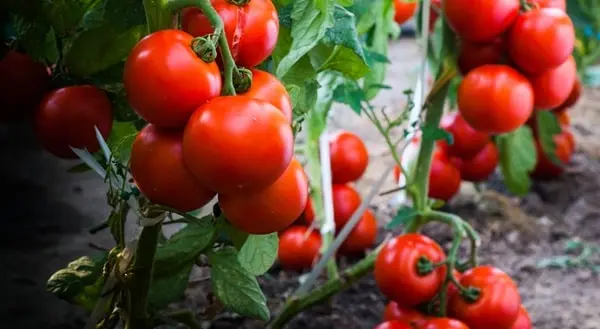Tomatoes add flavour to India’s regional and international cuisine, which is why there is a high demand for tomatoes within and outside the country. India holds the prestigious title of the second-largest tomato producer in the world, and several states contribute significantly to this achievement. Amidst the few, Madhya Pradesh, Andhra Pradesh, Karnataka, Gujarat, and Bihar have had their turns as drivers of the process, heaped together as the country’s tomato addiction.

Let us know about the top 5 Highest Tomato Producing States in India.
1. Madhya Pradesh:
Madhya Pradesh advances its tomato farming, successfully exploiting the vast arable area of the state with effective agricultural policies. The areas of Dewas, Ratlam, and Ujjain have even emerged as tomato greenhouse farming operation centers in recent years. The main focus of the state on promoting sustainable agriculture through organic practices and efficient water management has greatly imparted to the farmers who have had the best of their reason to use the new, better farming methods. Another environmental benefit is the development of processing industries and cold storage services that have helped allow the reaping of higher yields and reduce the wastage incurred during post-harvest handling.
2. Andhra Pradesh:
Andhra Pradesh is the second highest tomato producing state in India, clearly stating the state has favorable agro-climatological conditions and an excellent agricultural infrastructure. The areas in this state’s three districts, Chittoor, Krishna, and Guntur, are most favorable for growing tomatoes under the front of agriculture. A supply of resources and the policies of the government that champion new farming methods have become the conditions that enable Andhra Pradesh to become a dominant state in tomato production. Such steps include subsidizing drip irrigation systems and making quality seeds more accessible. This has placed the state as one of the top-level tomato producers on the national scene.
3. Karnataka:
Tomato production for Karnataka remains at the forefront through its varied agro-climatic zones and smart agro-farming methods. Places like Kolar, Bangalore Rural, and Belgaum in India are acknowledged for growing more tomatoes. The state’s decision to embrace greenhouse farming and research development implies that tomato cultivation techniques have changed with introducing new seed species. Furthermore, government initiatives that boost farmers’ education and support these farmers through credit facilities have enabled them to optimize their yields and quality, a course that continues to consolidate Karnataka’s position as a leading tomato-producing state.
4. Gujarat:
Gujarat takes the position of spot in the Indian tomato production market, which is man-made by the spirit of entrepreneurs and the agroecosystem. Shahyats generates vegetal production tomatoes in Mehasana, Sagarkantha, and Ahmedabad as examples that continue to grow. The state’s emphasis on technology-driven farming, which involves precisely farming and tractors in tomato farms, has resulted in increased production and efficiency. In addition, the favorable strategic position of Gujarat and the outstanding road, rail, and air transportation system find our tomato farmers and traders equally, facilitating them vast domestic and international market access, thus paving the way for growth opportunities.
5. Bihar:
Despite being a country with extremely limited natural resources, India is managing to create room for its agricultural development. India is moving ahead. In the south of Bihar, Vaishali remains greater than the other two tomato-producing centers, which does the ancient capital city, Nalanda, soon follow Samastipur. The state government distributed the funds as a reward to the farmers for their increased tomato cultivation plans. Modernized orchard endeavors consisting of mulching and fertigation have given rise to crops in Bihar, adding to the revenues from exporting tomatoes.
Conclusion:
Andhra Pradesh, Madhya Pradesh, Karnataka, Gujarat, and Bihar will bring in the majority of production in India through tomatoes in 2024. Achievements might be possible because of fair weather, smart policies, and farmer empowerment initiatives. These inequality-free regions, in turn, create tremendous pride for the Indian farming fraternity as they keep working towards sustainability and food security.
FAQs
Q1. So, what role do these states play in developing the total tomato production in India?
Ans: These states, specifically, are responsible for a major portion of the tomato yield in India because they have good climatic conditions, advanced agronomic practices, and extensive cultivation areas. Together with the total output, a substantial proportion is supplied to the local market, which is mandated for domestic consumption, and at the same time, the export requirements are met.
Q2. What elements give these states the power to dominate tomato cultivation?
Ans: The predominant tomato-growing states have perfect soil conditions, ample irrigation water, advanced agricultural techniques, an educated workforce, and supportive government policies. Maturing agricultural systems and efficient means of transportation promote distribution, increase production efficiency, and give tomatoes a competitive edge in the market.
Q3. What challenges do the principal tomato-producing state meetings face in retaining their status?
Ans: Tomato production faces challenges such as water, insects, and price fluctuations. Addressing these problems requires new ideas and concerted action.
Related Articles:
- Top 5 Most Chilli Producing States in India
- Top 5 Most Onion Producing States In India
- Top 5 Most Potato Producing States In India
- Top 5 Most Vegetable Producing States in India

